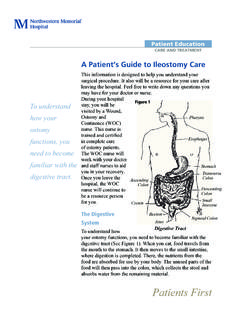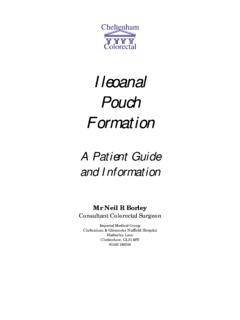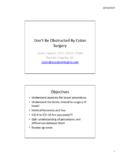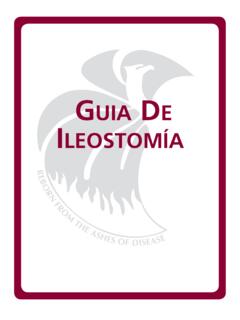Transcription of Reversal (closure) of loop ileostomy - Christie …
1 1 Reversal (closure) of loop ileostomy This booklet has been written to provide you with information about Reversal (closure) of your ileostomy . More than 6,000 people undergo Reversal of their stoma every year. This following information will provide details about what the surgery involves, common problems which can be experienced after Reversal and how to manage them. What is a loop ileostomy /colostomy? A loop ileostomy is a temporary stoma which was formed at your initial surgery from the small bowel (ileum). Formation of a stoma allows the bowel to rest by diverting faeces away from the bowel while it heals from a surgical anastomosis (a sutured or stapled join in your bowel following bowel surgery). These stomas are created for a minimum of six weeks but are often present for over six months depending on the need for post-operative chemotherapy.
2 The length of time you have the stoma will depend on your general health and recovery from your initial surgery as well as the indication for your surgery and formation of the stoma. What investigations do I need before Reversal ? When you see the consultant, arrangements will be made for you to have some investigations prior to planning Reversal of your stoma. These investigations may include: Flexible sigmoidoscopy - to assess the anastomosis (a sutured or stapled join in your bowel following bowel surgery) endoscopically to ensure that this has healed. Gastrografin study (enema) - an enema is given to assess the anastomosis radiologically to ensure that there are no leaks and to ensure that this has healed. CT scan - to assess for any sites of disease recurrence prior to Reversal . Once your consultant is satisfied, they will arrange for you to be listed for Reversal of your stoma.
3 Are the alternatives to surgery? If you choose not to have surgery to reverse your stoma, you would keep your stoma. This could be reversed at a later date or not at all. Consent Your surgeon will explain the procedure and the reasons why this procedure is an option for you. It is important that you understand what the planned treatment involves and that you have been given the opportunity to discuss any concerns. This information is a permanent record of what has been explained. We will ask you to sign a consent form agreeing to accept the treatment that you are being offered. The basis of the agreement is that you have had The Christie s written description of 2 the proposed treatment and that you have been given an opportunity to discuss any concerns. You are entitled to request a second opinion from another doctor who specialises in treating this cancer.
4 You can ask your own consultant or your GP to refer you. Your consent may be withdrawn at any time before or during this treatment. Should you decide to withdraw your consent then a member of your treating team will discuss the possible consequences with you. What happens before your operation? You will be asked to attend for a pre-operative assessment. At this appointment a nurse will: ask questions about your past medical history assess your heart and lung function take a blood specimen to assess your suitability/fitness for surgery take swabs from your skin to screen for MRSA give you information about the enhanced recovery programme ask if you have any questions about your operation. The date of your surgery may be given to you by the time you attend the pre-admission clinic. Before your surgery you will be admitted to the ward either on the day of surgery or the day before.
5 You will not be allowed to eat or drink before the operation for a few hours and the information regarding this will be provided at the pre-operative assessment. The timing will depend on the time of your surgery. In addition, it is not necessary to give you oral bowel preparation before your operation but an enema may be given based on the need. How long does the operation take? The surgery generally takes 1 to 2 hours to complete. How long will I be in hospital? The length of stay varies from patient to patient but on average this is usually between 3-5 days. Usually once your bowels have opened your discharge will be planned. What does the surgery involve? Reversal (closure) of your stoma is not as complex as your previous surgery to create the stoma. The surgery is performed under a general anaesthetic and involves taking the two ends of your stoma and stitching or stapling (joining) them together.
6 A small cut (incision) will be made by the surgeon around the stoma site to free up the bowel loops used to make the stoma. The surgeon will then join the two ends of bowel back together with either stiches or staples. At the end of the surgery the wound (abdominal wall) is stitched together and the skin is then closed. In some cases, the surgeon may need to re-open your original wound/scar (laparotomy) in order to facilitate Reversal (closure). What are the risks? As with any surgery, the surgery to reverse your stoma has a degree of risk of complications. There are general and specific complications which will be explained in detail to you by the surgeon. You will also be given advice on how to prevent these complications from arising. The general complications include: 3 chest infection (pneumonia) urinary tract infection blood clots to the leg (DVT or deep vein thrombosis) or lungs (PE or pulmonary embolus) heart irregularities due to the operation or anaesthetic bleeding from the operation site which may require a blood transfusion injury to nearby organs, tissues or nerves wound infection.
7 Whereas, the specific complications related to Reversal include: anastomotic leak (that is, where the colon has been joined together) bowel obstruction - due to scar tissue (adhesions) after abdominal surgery ileus - where the bowel stops working temporarily after being handled. Time is required to allow the bowel to rest before it starts working again development of hernias at the closure site risk of conversion to a laparotomy. What happens after the surgery? After your surgery you will be taken to the recovery area in theatre where you will be monitored until your condition is stable. Then you will be ready to return to the ward. On the ward, you will be able to drink when you feel able. For the first 24 hours after surgery we advise you to stick to liquids. You should be able to start eating within 1 to 2 days depending on how you are feeling.
8 You will also be encouraged to move around as soon as possible after your surgery. This will help to improve your recovery and reduce the risk of certain complications What to expect when your bowels start to work again after surgery The rectum acts as a reservoir or storage area for faeces, and when part of this has been removed has an impact on bowel function and control. After your Reversal it will take time for your bowel function to settle into some sort of a pattern. The time period varies from person to person. It will also vary depending on how much bowel (colon) was removed at your initial surgery and whether you have had pre or post-operative treatments such as radiotherapy or chemotherapy. Your bowel function can be erratic for the first few weeks following stoma Reversal . It is difficult to predict how problematic bowel function will be. The following symptoms are regarded as common: loose motions increased frequency urgency to go to the toilet - can include some incontinence or spotting difficulty determining wind from motion sore skin around the back passage (requiring the application of barrier cream) fragmentation of stool resulting in incomplete emptying.
9 These symptoms should improve over the first year following Reversal . Support and practical strategies are available to improve your bowel control, bowel motion consistency and 4 decrease any frequency and urgency you may be experiencing. Detailed bowel assessment, dietary advice, medications and pelvic floor exercises can help and require specialist input. When will I be allowed home? Generally, you will be an in-patient for approximately 3 to 5 days. It is common after Reversal of your stoma to experience looser and more frequent stools. You will be reviewed by your surgeon in the follow up clinic 4-6 weeks after your surgery. Going home On discharge from the ward we will provide you with a supply of painkillers to take home. If you remain uncomfortable when you complete your supply of painkillers, your GP can prescribe more. Sometimes Imodium (Loperamide) is prescribed if your bowels are loose.
10 The ward staff will arrange for a district nurse to visit you at home to check on your dressings. Getting back to normal Generally you will recover quickly following stoma Reversal . It is normal to feel weak and tired on discharge home, mainly because your body is recovering from the stress of surgery. However, it is important to allow yourself some time to return to normal activity. Gentle exercise such as walking is encouraged upon discharge. You will be able to start driving again when you are able to make an emergency stop without feeling pain. This may take up to six weeks and you are advised to contact your insurance company before driving again. Returning to work varies from one person to another. People with jobs that are not physically demanding (for example office work) can often return to work within three weeks of their operation. Physically demanding jobs may require a longer (4-6 weeks) time resting.








